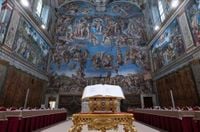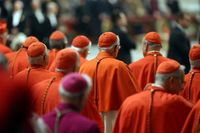The Konklawe 2025 began on Wednesday, May 7, 2025, in Vatican City, marking a significant event in the Roman Catholic Church as cardinals gather to elect a new pope. At 10:00 AM, cardinals convened in St. Peter's Basilica for the "Pro eligendo Papa" mass, a solemn ceremony led by Cardinal Giovanni Battista Re, the Dean of the College of Cardinals. This mass is traditionally held to pray for the guidance of the Holy Spirit in the selection of the new pontiff.
Later that day, at 4:30 PM, the cardinal-electors entered the Sistine Chapel, where they will be isolated from the outside world to conduct the papal election. This conclave is particularly notable as it features a record 133 cardinal-electors from 71 countries, with approximately 80% of them appointed by the late Pope Francis. Cardinal Pietro Parolin, the oldest cardinal-bishop eligible to participate, will preside over the proceedings.
The conclave, steeped in centuries of tradition, is characterized by its strict security measures and the secrecy surrounding the election process. As the cardinals enter the Sistine Chapel, they take an oath to maintain confidentiality about the discussions and votes during the conclave. This oath is taken seriously, with severe consequences, including excommunication, for any breaches of secrecy.
Voting will occur in the chapel, with a maximum of four votes conducted each day—two in the morning and two in the afternoon. To elect a new pope, a candidate must receive a two-thirds majority of the votes, which translates to 89 votes out of the 133 electors. The results of each voting session will be communicated to the public through the smoke emitted from the chapel’s chimney: black smoke indicates no decision has been reached, while white smoke signifies the election of a new pope.
If the conclave operates smoothly, a new pope could be elected and announced between May 7 and May 10, 2025. The first vote is anticipated on the evening of May 7, with initial results expected around 8:00 PM. Following the first round of voting, the cardinals will continue to vote until a consensus is reached.
Among the cardinal-electors are four from Poland: Stanisław Ryłko, Kazimierz Nycz, Konrad Krajewski, and Grzegorz Ryś. All are eligible to vote as they are under the age of 80. Ryłko and Nycz were appointed by Pope Benedict XVI, while Krajewski and Ryś were nominated by Pope Francis.
The conclave is not just a religious event; it holds significant implications for international politics and social issues, including climate change, migration, and conflicts around the world. The new pope's stance on these matters will be closely watched, especially given the current global landscape.
As the cardinals prepare for the election, the atmosphere is charged with anticipation. The Sistine Chapel, adorned with Michelangelo’s stunning frescoes, serves as the backdrop for this historic event, blending the sacred with the solemnity of the task at hand.
In a modern twist, the conclave will utilize advanced technology to ensure the secrecy and integrity of the election process. Military jamming devices will block any unauthorized communication devices, preventing any leaks of information. The cardinals will be sequestered in the chapel, with their only communications being the votes they cast and the prayers they offer.
Historically, conclaves have varied greatly in length. The shortest conclave lasted just a few hours, while the longest extended over three years. However, in recent history, no conclave has lasted longer than five days. With the current conclave beginning on May 7, it is expected to conclude shortly after, although the exact timing remains uncertain.
As the world watches the events unfold, the significance of this conclave cannot be overstated. The selection of a new pope is a pivotal moment for the Catholic Church and its followers, impacting millions around the globe. The conclave not only reflects the internal dynamics of the Church but also resonates with broader societal issues and challenges.
In summary, the Konklawe 2025 is set to be a momentous occasion, combining ancient rituals with modern security measures in the heart of Vatican City. As the cardinals engage in this sacred duty, the eyes of the world will be upon them, waiting to see who will emerge as the next leader of the Catholic Church.
With the first vote scheduled for the evening of May 7, the anticipation builds. Observers will gather in St. Peter's Square, eager to witness the announcement of the new pope and the historic moment when the white smoke signals the conclusion of the conclave. The new pontiff will then appear on the balcony of St. Peter's Basilica to accept the homage of the faithful and share his first blessing with the world.
The selection of the new pope is not just a matter of church governance; it is a moment that encapsulates the hopes and aspirations of 1.4 billion Catholics worldwide. As the conclave unfolds, it will undoubtedly shape the future of the Church and its role in a rapidly changing world.

![Konklawe na żywo. Watykan wybiera nowego papieża [TRANSMISJA]](https://thumbor.evrimagaci.org/j-B8WEg7t8x78Cd319HtPfNLHxU=/200x0/tpg%2Fsources%2F771305de-4a8b-4bcd-85c2-3372bc49363a.jpeg)

